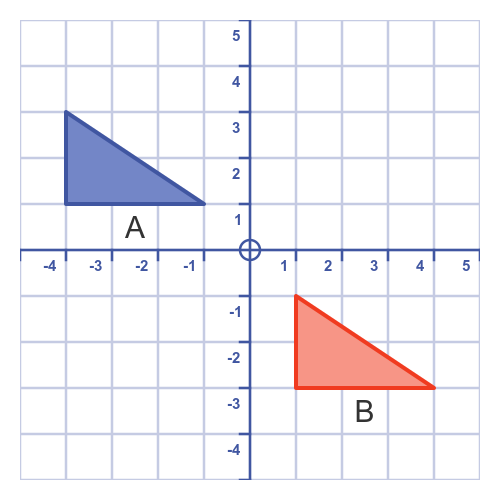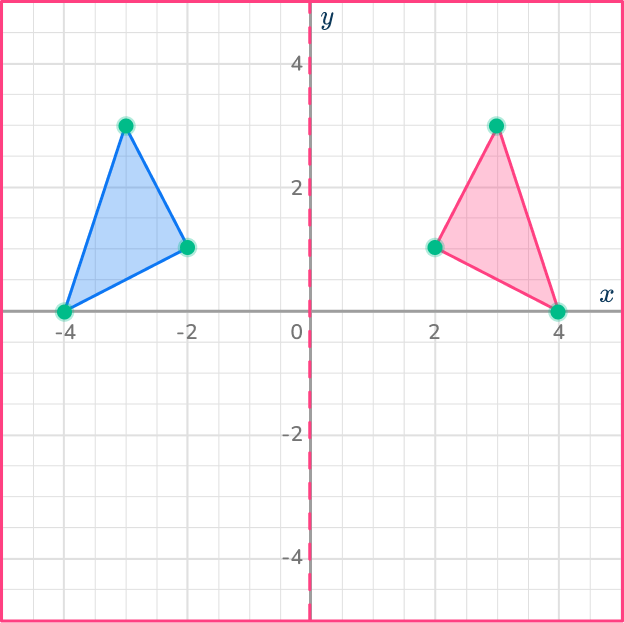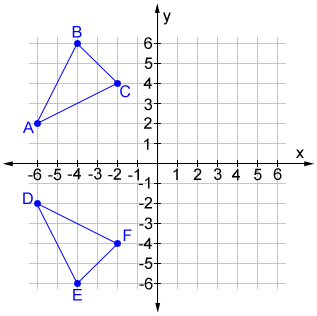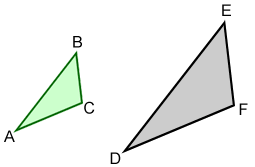Describe the rotation shown that takes the orange triangle onto the green triangle.
90 degree rotation about the origin.
Write the coordinate rule for a reflection over the x-axis.
(x, y) --> (x, -y)
Describe the translation that takes the blue triangle onto the red triangle in words.
Translate right 5 and down 4.
Dilations create __________ figures. (Similar or congruent?)
Similar
Which transformations can create congruent figures? Name each one.
Rotations, Reflections, and Translations
Describe the rotations shown that takes the red triangle onto the blue triangle.
180 degree rotation about the origin.
Describe the reflection that takes the blue triangle onto the red triangle.
Reflection over the y-axis.
Describe the translation that takes the blue triangle onto the red triangle in words.
Translate left 6 and up 2.
Determine the scale factor for the dilation that takes the blue triangle onto the orange triangle.
3
A triangle is rotated 90 degrees clockwise about the origin, reflected over the y-axis, then translated down 2 units. Is the resulting triangle similar or congruent to the original triangle? Explain how you know.
Yes, those transformations are rigid transformations that do not change the size or shape of an object.
Describe the rotation that takes triangle ABC onto the red triangle.
90 degree counterclockwise rotation about C.
Describe the reflection that takes triangle ABC onto triangle DEF.
Reflection over the x-axis.
Write the coordinate rule that describe the translation shown.
(x, y) --> (x + 7, y - 8)
Which scale factor could take the grey triangle onto the green triangle.
(a) 2.5 (b) -2 (c) 0.5 (d) -0.5
(c) 0.5
A rectangle is dilated by a scale factor of 1.5, reflected over the y-axis, then rotated 90 degrees clockwise. Is the resulting triangle similar or congruent to the original triangle? Explain how you know.
Similar, a dilation occurred which changed the triangle's size.
Describe the rotation that takes the red parallelogram onto the green parallelogram.

90 degree rotation counter clockwise about the point (-3, 4).
Describe how to take the orange triangle onto the pink triangle using reflections.
Reflect over the x-axis, then reflect over the y-axis.
Reflect over the y-axis, then reflect over the x-axis.
Write the coordinate rule for the translation that takes the blue triangle onto the red triangle.
(x, y) --> (x + 8, y - 7)
True or false: All sides and angles are multiplied by the scale factor during a dilation.
False, angles do not change.
Are the triangles shown similar? If so, what is the scale factor?

Yes, the scale factor is either 2 or 0.5.
Describe the rotation that takes the blue trapezoid onto the orange trapezoid.
180 degree rotation about the point (3, 1)
What single transformation is equivalent to a reflection over the x-axis followed by a reflection over the y-axis?
180 degree rotation about the origin.
Write a coordinate rule for a translation down 9 units.
(x, y) --> (x, y - 9)
Determine the scale factor that would map quadrilateral A onto quadrilateral B.
3/4 or 0.75
Are the shapes shown similar? If so what is the scale factor?
No

